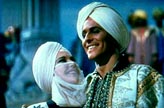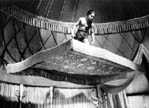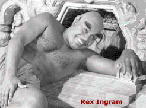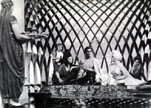
|
|
Ahmad, Abu and Jafar January 15, 2002
It is filled with images of turbans, sorcery, forbidden love, chases, obligatory flying carpets and last but not least the pursuit of happiness. This film is a love story emerging from a fairy tale with a cool-headed, cold-hearted villain. Binding it all together is a buoyant spirit and a celebration of Far Eastern Legends that makes of this one of the most delightful fantasy films of all time. In this wonderful story we travel with Ahmad (John Justin) and Abu (Sabu) on their attempt to rescue the beautiful Princess (June Duprez) from the clutches of the evil Vizier Jaffar (Conrad Veidt). At first, the story is told in the past tense by Ahmad, who having been blinded by Jaffar, searches for his love, the Princess. We find that Jaffar originally deposed Ahmad (the rightful King of Baghdad) from his royal seat with the intention of killing him and taking control. However, Ahmad manages to escape with the help of the young thief, Abu (Indian child star Sabu), to Basra and freedom. Here, he falls in love with the Princess, in a delightful sequence where he pretends to be the genie in the pool. Unfortunately Jaffar also desires the Princess and attacks Ahmad again. Tempting the Princess' father, the old Sultan, with magical toys, Jaffar blinds him and turns Abu into a dog.
Only with the help of an entrapped genie (Rex Ingram) are the friends able to turn the tables on Jaffar and restore Ahmad to the throne, with the Princess as his bride. Throughout this movie, the incredibly vivid colors of the Technicolor process dazzle and draw us deeper into this larger-than-life fantasy. In a classic fashion, Ahmad and Abu overcome stupendous obstacles with a mixture of guile, wit, friendship and courage as they battle the thoroughly nasty Jaffar. With the victory of "Good over Evil " Ahmad and his Princess are united at last, but Abu sets off on his flying carpet for further adventure. Although the success of Douglas Fairbanks' original "Thief of Baghdad" in 1923 inspired the Korda brothers 1940's remake, the two versions are highly dissimilar in style. Watching "The Thief of Baghdad", it is not at all difficult to understand why the Korda's version is so lauded.
Writers Biro and Malleson had to start practically from scratch. While they did have color and sound at their disposal, they lacked a heroic figure of Fairbanks' quality and stature. Sabu Dastiger ( only major Indian actor to have made it in Hollywood's Golden Era could hardly be expected to match Fairbanks on neither a physical nor acting basis. Sabu had but two films to his credit at the time (Robert Flaherty's "Elephant Boy" and Korda's The Drum"). Therefore, could the movie conceivably focus on the Prince and Princess? I think not. Especially not when the roles were played by John Justin, blue-eyed, handsome, but a lightweight actor, and June Duprez, with only a few movies under her belt. These actors looked right (especially Sabu and Duprez) but could not carry an expensive picture. Alexander Korda, however, had an artistic ace in the hole. Conrad Veidt, who had started acting in German silent films ("The Cabinet of Dr. Caligari") was a popular performer in England and the United States by 1939. Veidt had only four years to live at the time. He died of a heart attack in April of 1943. In re-forming this fairy tale around Veidt, Korda supplied the actor with what some consider his most memorable role, Caligari and Casablanca not withstanding. The new film opened with Veidt brooding over the shipyard set. He became, in effect, the main character, and what was lost in audience identification with the titular leads was gained in fascination with this cloaked and turbaned king of devils.
With these engaging overlays, we willingly overlooked the Prince's terminal naivete and the fact that this vacuous Princess hardly seemed worthy of her father's edict that 'whoever looks upon her shall be killed'. With mechanical cleverness, rich color, sumptuous costumes, gleaming sets and a whole textbook of optical maskings, Korda managed to persuade us. The Thief of Baghdad's setting is a city-state of fierce social injustice. The people are oppressed and their only hope is the prophecy of a hero. They are the lowest of the low, who will someday strike down their rulers. The nominative head of government knows nothing of their plight since his second-in-command runs the show. This vizier possesses magic, and magical devices which may be stolen and used for good purposes, but is beyond the understanding of the people.
This is the film that finally gave justice to Alexander Korda's uncredited talent as a producer in the US, as well as a reputation to Michael Powell as one of Britain's finest directors. Besides the utilisation of the Technicolor process and the onset of WWII, Korda faced numerous other headaches in making this film. First, the British government decided that all film production during the war years had to be for the purposes of propaganda. This pushed the remainder of the shoot and post-production of the film off-shores to America. The large Baghdad and Basra Sea port sets were shot in Britain while the old Baghdad scene was relocated to the Mojave Desert in California. Second, Prudential Assurance, London's film financier, withdrew their funding from any future films due to Korda's previous unremunerative extravagances.
Interesting to note that the evil Jaffar and the fifty-foot bottled Genie characters outlived their creators because they inspired Disney Studio artists in producing another adaptation of a Far Eastern tale; that of " Alladin " in a the Animated Cartoon released in the 90's. Thus, upon its timely release on Christmas Eve in 1940, "The Thief of Bagdad" heraled for the British cinema as :" a decade of astonishing achievement...sublimely indifferent to that respectable national illness known as 'documentary'... no-one else made the cinema such an Ali Baba's cave in such gloomy, cautious years." Sixty two years after its first release, this film has not aged and can be watched by young and old alike as a delightful hocus-pocus of color, dashing adventure and special effects. The thief of Bagdad can be purchased from amazon.com.
|
|
 |
Web design by BTC Consultants
Internet server: Global Publishing Group























 Afterwards, we enter the present where the Princess has fallen
into an enchanted sleep, pining for her true love. Ahmad wakes her only
to find that she is immediately kidnapped by the evil Jaffar and taken away
by ship. Soon Ahmad and Abu give chase but Jaffar is too powerful and almost
destroys them with his spells.
Afterwards, we enter the present where the Princess has fallen
into an enchanted sleep, pining for her true love. Ahmad wakes her only
to find that she is immediately kidnapped by the evil Jaffar and taken away
by ship. Soon Ahmad and Abu give chase but Jaffar is too powerful and almost
destroys them with his spells. This Eastern fantasy is full of wonderous effects, bigger-
than-Ben-Hur sets, and beautiful people. Moreover, as the winner of three
Academy Awards, including Best Picture, Best Special Effects, and Best
Cinematography and a Musical Score nomination for Miklos Roszait is one
of the greatest British Technicolor films .
This Eastern fantasy is full of wonderous effects, bigger-
than-Ben-Hur sets, and beautiful people. Moreover, as the winner of three
Academy Awards, including Best Picture, Best Special Effects, and Best
Cinematography and a Musical Score nomination for Miklos Roszait is one
of the greatest British Technicolor films . By saving this film's central figure, the Kordas were free
to provide a battery of special effects to keep their scenes from degenerating
into fluff. There was the misty, echoing chamber, in which Sabu reprised
his song I Want To Be a Sailor before battling a giant spider. There
was also the large, doll that killed the Old Sultan Miles Malleson. Ex-physician
Rex Ingram, another movie veteran, carved a permanent niche into every viewer's
memory as the noisy and untrustworthy genie.
By saving this film's central figure, the Kordas were free
to provide a battery of special effects to keep their scenes from degenerating
into fluff. There was the misty, echoing chamber, in which Sabu reprised
his song I Want To Be a Sailor before battling a giant spider. There
was also the large, doll that killed the Old Sultan Miles Malleson. Ex-physician
Rex Ingram, another movie veteran, carved a permanent niche into every viewer's
memory as the noisy and untrustworthy genie. Korda's film typifies the "returning home" fairy-tale
theme; the re-establishment of peace and justice. The System and its mystical
rules can be countered and controlled. In this film, a struggle is established,
action undertaken and the powerful eventually fail. The basic conflict is
one of social extremes; power and wealth versus impotent poverty, with no
middle ground. However, there are traditional religious aspects, too, such
as in the prophecy
Korda's film typifies the "returning home" fairy-tale
theme; the re-establishment of peace and justice. The System and its mystical
rules can be countered and controlled. In this film, a struggle is established,
action undertaken and the powerful eventually fail. The basic conflict is
one of social extremes; power and wealth versus impotent poverty, with no
middle ground. However, there are traditional religious aspects, too, such
as in the prophecy Luckily, Michael Powell was waiting in the wings and was convinced
by Korda himself into directing. He claims credit for the sequences with
Sabu and the Djinni with a few exceptions. The scenes with Sabu are particularly
indicative. His delightful quick wit and his wonder at the magical world
around him, facilitates the film's harking back to the fantastic trick cinema
of Melies, French Magician and special effects cinema pioneer.
Luckily, Michael Powell was waiting in the wings and was convinced
by Korda himself into directing. He claims credit for the sequences with
Sabu and the Djinni with a few exceptions. The scenes with Sabu are particularly
indicative. His delightful quick wit and his wonder at the magical world
around him, facilitates the film's harking back to the fantastic trick cinema
of Melies, French Magician and special effects cinema pioneer.